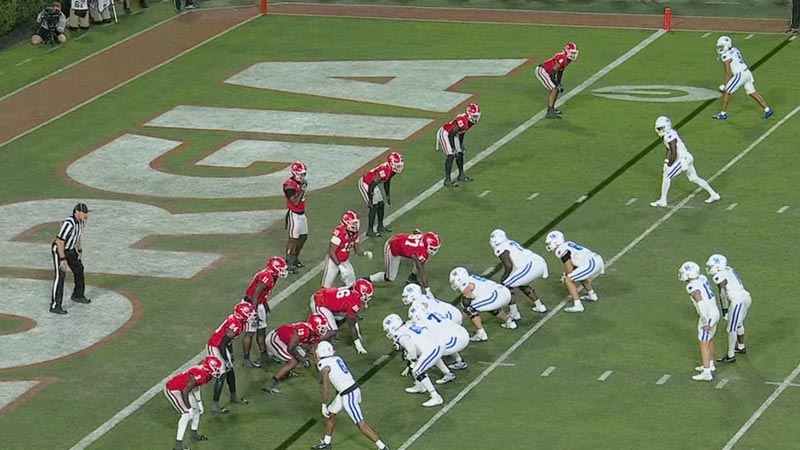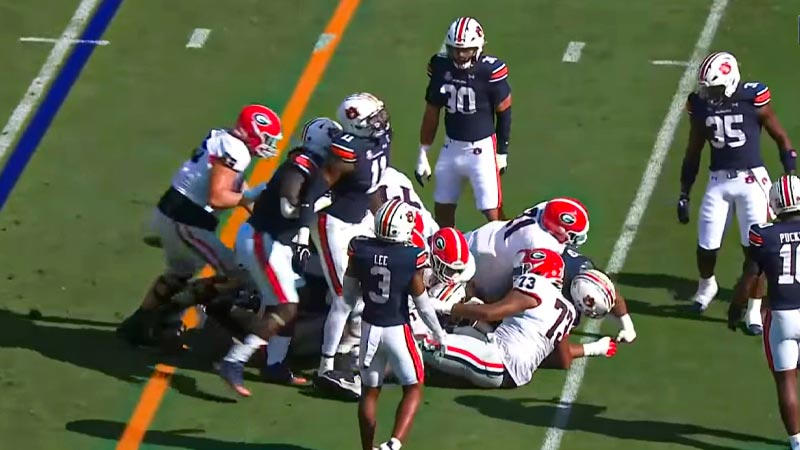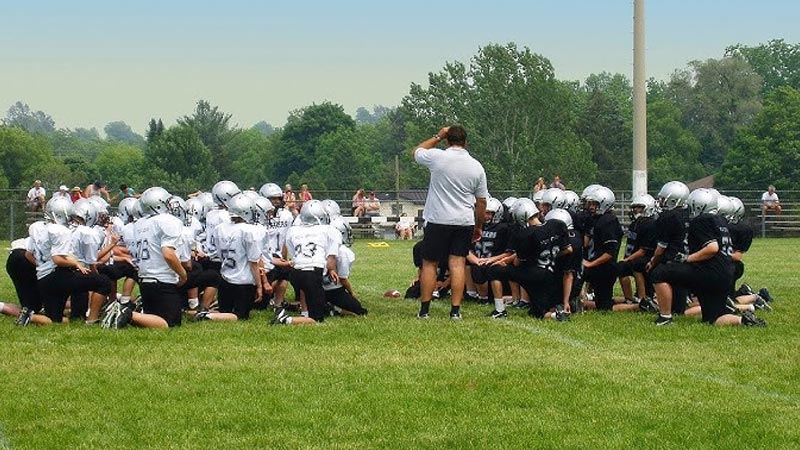In the world of college football, the pursuit of talent is an intricate dance between universities and aspiring athletes. College football recruiting is a high-stakes process that determines the future of both players and programs.
From the meticulous evaluation of prospects to the intense competition among schools, the recruitment journey is a captivating blend of strategy, skill, and ambition.
In this guide, we will delve into how college football recruiting works, shedding light on the key players, processes, and factors that shape this dynamic landscape.
We will explore the various stages of recruitment, from identifying potential recruits to securing commitments, and examine the strategies employed by coaches and universities to attract the best talent.
Join us as we unravel the mysteries of college football recruiting, providing you with a comprehensive understanding of how this captivating process unfolds.
How Does College Football Recruiting Work?
First, let’s take a closer look at the key components and stages of this intricate process, shedding light on the strategies, evaluations, and decisions that shape the landscape of college football.
Identifying Prospects
The first step in college football recruiting is identifying potential prospects. Coaches and recruiters scour the country, attending high school games, tournaments, and showcases to spot talented athletes.
They rely on a network of contacts, including high school coaches and scouting services, to discover promising players who possess the skills and potential to excel at the collegiate level.
Evaluating Talent
Once prospects are identified, the evaluation process begins. Coaches meticulously assess a player’s physical attributes, technical skills, and football IQ. They analyze game footage, attend practices, and conduct in-person evaluations to gauge a player’s abilities and potential fit within their program.
This evaluation process involves assessing a player’s speed, strength, agility, football instincts, and overall athleticism.
Building Relationships
Building strong relationships with prospects is a crucial aspect of college football recruiting. Coaches invest time and effort in establishing connections with players and their families, showcasing the benefits of their program and university.
They communicate through phone calls, emails, and in-person visits, aiming to establish trust and rapport with the prospect. These relationships play a significant role in a player’s decision-making process.
Extending Offers
Once a coach is convinced of a prospect’s potential, they extend a scholarship offer. Scholarships provide athletes with the opportunity to receive a quality education while playing football at the collegiate level.
These offers typically include financial aid packages that cover tuition, room and board, and other expenses.
The number of scholarships available varies by division and conference, and coaches must carefully manage their resources to build a balanced and competitive team.
Commitment and Signing
When a prospect receives multiple scholarship offers, they must make a decision. This decision is often influenced by factors such as the program’s success, coaching staff, academic reputation, facilities, and proximity to home.
Once a prospect commits to a university, they sign a National Letter of Intent (NLI), which binds them to that institution. The signing period typically occurs during a designated period in the player’s senior year of high school.
National Signing Day
National Signing Day is a highly anticipated event in college football recruiting. It marks the culmination of the recruiting process, as prospects officially sign their NLIs.
This day is celebrated by fans, coaches, and universities, as they eagerly await the arrival of their new recruits. Media coverage and rankings add to the excitement, as the nation’s top recruiting classes are unveiled.
NCAA Recruiting Rules

NCAA recruiting rules play a vital role in shaping the landscape of college football recruiting. Here are the rules you need to know about:
Contact Periods
The NCAA establishes specific contact periods during which coaches can communicate directly with prospective student-athletes.
During these periods, coaches can make in-person visits to a prospect’s school or home, have phone conversations, and send electronic communications.
It is important for coaches to adhere to these contact periods to ensure compliance with NCAA rules.
Dead Periods
Dead periods are periods during which coaches are not allowed to have any in-person contact with prospective student-athletes. During dead periods, coaches cannot visit prospects’ schools or homes, and prospects cannot visit college campuses.
Dead periods are typically implemented to allow prospects and their families time to make decisions without external pressures.
Official and Unofficial Visits
Prospective student-athletes can take official visits to colleges, which are fully funded by the university. These visits allow prospects to experience the campus, meet with coaches and players, and get a feel for the program.
Unofficial visits, on the other hand, are visits that prospects and their families pay for themselves. Prospects can take unofficial visits at any time, but there are restrictions on the number of official visits they can take.
Recruiting Materials and Communication
Coaches are allowed to send recruiting materials, such as brochures and questionnaires, to prospective student-athletes. However, there are restrictions on the timing and frequency of these communications.
Coaches must also be mindful of the content of their communications, as they are prohibited from making exaggerated claims or promises to prospects.
Evaluation Periods
The NCAA designates specific evaluation periods during which coaches can evaluate prospects’ athletic abilities. Coaches can attend high school games, tournaments, and showcases to assess a prospect’s skills and potential.
It is important for coaches to adhere to the rules regarding evaluation periods to ensure fair and ethical recruiting practices.
National Letter of Intent (NLI)
The NLI is a binding agreement between a prospective student-athlete and a university. By signing the NLI, the athlete commits to attending the university for at least one academic year, and the university commits to providing athletic financial aid.
The NLI signing period is typically a designated period in the prospect’s senior year of high school.
How to Get Recruited in College Football?

Getting recruited in college football requires a combination of talent, hard work, and strategic planning. Here are some key steps to increase your chances of getting noticed by college football programs:
Develop Your Skills
Start by honing your football skills and improving your athletic abilities. Attend camps, clinics, and off-season training programs to enhance your technique, speed, strength, and agility. Work with coaches and trainers who can help you reach your full potential as a player.
Build a Strong Academic Profile
College football programs not only look for talented athletes but also for students who excel academically. Maintain good grades throughout high school and take challenging courses.
Achieving a high GPA and performing well on standardized tests like the SAT or ACT will make you a more attractive candidate to college coaches.
Create a Highlight Reel
Put together a high-quality highlight reel showcasing your best plays and skills. Make sure to include a variety of game footage that demonstrates your versatility and abilities in different situations.
Share your highlight reel with college coaches and upload it to recruiting platforms or your personal website.
Attend Camps and Showcases
Participate in football camps and showcases where college coaches and recruiters are present. These events provide an opportunity to showcase your skills in front of college programs and receive direct feedback.
Research and target camps that are attended by coaches from schools you are interested in.
Reach Out to College Coaches
Take the initiative to contact college coaches and express your interest in their program. Send personalized emails or make phone calls to introduce yourself, provide your highlight reel, and share your academic and athletic achievements.
Be proactive in building relationships with coaches and ask for their feedback on your skills and potential fit within their program.
Utilize Recruiting Platforms
Create profiles on reputable recruiting platforms that college coaches frequently use. Include your academic information, athletic achievements, highlight reel, and contact details.
Regularly update your profile with new accomplishments and engage with coaches who show interest in your profile.
Attend College Camps and Visits
If you receive invitations to attend college camps or visits, take advantage of these opportunities. It allows you to showcase your skills in front of the coaching staff and get a firsthand experience of the program.
Use these visits to ask questions, learn more about the school’s academic offerings, and assess the overall fit.
Stay Focused and Persistent
The recruiting process can be challenging and competitive. Stay focused on your goals, work hard, and remain persistent. Keep improving your skills, maintain good academic standing, and continue reaching out to coaches.
Remember that the recruiting process takes time, and opportunities may arise at any point during your high school career.
Getting recruited in college football requires a combination of talent, hard work, and proactive engagement with college coaches.
By developing your skills, maintaining good academic standing, showcasing your abilities, and building relationships with coaches, you can increase your chances of getting noticed and securing a spot on a college football team.
FAQs
How do college football coaches evaluate prospects?
College football coaches evaluate prospects through a combination of methods. They analyze game footage, attend high school games, and evaluate prospects in person during camps and showcases.
How do college football recruiting rankings work?
Recruiting rankings are determined by various scouting services and media outlets. These rankings are based on evaluations of prospects’ skills, performances in games and camps, and potential impact at the collegiate level. Rankings consider factors such as athleticism, size, position-specific skills, and overall potential.
Can college football programs offer scholarships to any high school athlete?
No, college football programs have a limited number of scholarships they can offer each year. The number of scholarships available varies depending on the division and conference. Coaches must carefully manage their resources and make strategic decisions on which athletes to offer scholarships to.
Can high school athletes contact college coaches?
Yes, high school athletes can contact college coaches to express their interest in a program. It is important for athletes to take the initiative and reach out to coaches, providing them with relevant information such as their highlight reel, academic achievements, and upcoming game schedules.
Can college football recruits change their commitment after signing a National Letter of Intent (NLI)?
While the NLI is a binding agreement between a recruit and a university, there are circumstances where recruits can be released from their commitment. For example, if there is a coaching change at the university, recruits may be granted a release from their NLI.
Bottom Line
As we conclude our journey through the intricacies of college football recruiting, we hope that this guide has provided you with valuable insights into the inner workings of this captivating process.
From the initial identification of prospects to the final commitment, the world of college football recruiting is a dynamic and ever-evolving landscape.
By understanding the strategies, processes, and factors that shape this dynamic realm, we can appreciate the dedication, hard work, and passion that goes into building successful college football programs.
So, whether you’re a fan cheering from the sidelines, a player dreaming of a college football career, or simply someone fascinated by the intricacies of the game, we hope this guide has deepened your understanding and appreciation for the fascinating world of college football recruiting.







